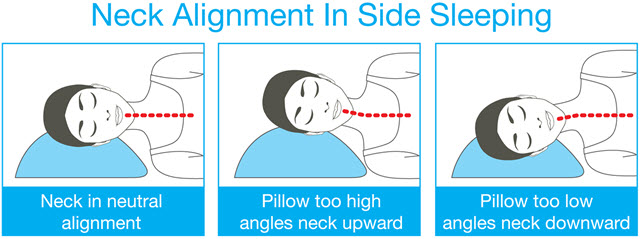Neck pain
Anatomy
The neck (cervical spine) is made up of seven small vertebrae which are connected by joints, ligaments, muscles and between each vertebrae there are discs. The upper two vertebrae in the neck bear the brunt of any turning movements (rotation) while the forward flexion and backward extension takes place mainly in the 4-6th cervical vertebrae.
The main job of the neck is to hold up and support your head. The head weighs between 10-12 lbs which is quite a weight. The muscles and ligaments can cope with this weight if the head is held in the correct position however sadly we rarely hold our necks in the correct position. Even holding the neck forward by 15 degrees such as looking at a phone or computer magnifies the weight to more like 27lbs. The further it is lowered, the more the weight goes through it and the system is not well suited to sustain this posture.
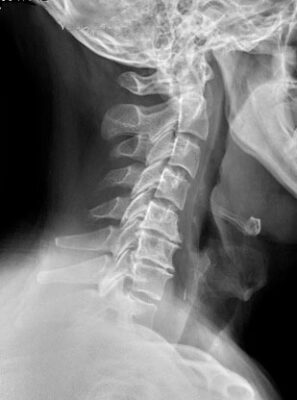

Many neck pains might appear to come on suddenly overnight but in fact may be a culmination of months and years of poor posture.
Preventing postural neck pain involves thinking about how you sit at home and work and see if you can change things.
See Ergonomics article

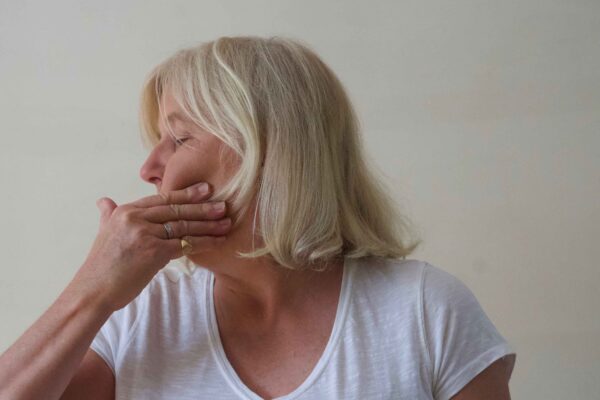
Top Tips are:
1. Do not poke your chin out when you are sitting at your computer, driving or watching TV
2. Make sure your desk is at the correct level
3. Check your chair is correct for you with a lumbar support
4. Sit well back in the chair with your back supported
5. Take lots of breaks from the computer
6. Perform simple exercises regularly at your desk
The neck is prone to injury in falls, car accidents and in sport.
The neck is also affected by degenerative changes which cause the growth of osteophytes (bony growths) along the edge of the vertebral bodies which can lead to pressure on the nerves as they emerge from the spine.
Any pressure on the nerve can lead to symptoms of pain in the neck which can radiate up the neck to the skull causing headaches, down the neck towards the shoulder blades and pain can extend down the arms even as far as the hands. These symptoms can also be pain, tingling and/or numbness.
Most common causes of neck pain
-Muscular skeletal postural strain
-Injury- such as a fall or whiplash
-Osteoarthritis/ Spondylosis of the neck
-Rheumatoid arthritis
-Osteoporosis- see article on osteoporosis
Less common causes are
– Disc prolapse
– Spinal stenosis where there is narrowing of the spinal column for whatever reason and this causes pressure on the spinal cord or the nerve roots as it exits the vertebrae. This can be due to long-term inflammation caused by arthritis or other conditions.
– Infections such as Meningitis
– Cancer
Most neck pain settles within a week or so but if you have had an accident and the symptoms are very acute it is best to seek advice from your GP.
Seek urgent advice if you have:-
– Any numbness into the hands
– Inability to move your arms
– Acute problem swallowing
– Feeling generally unwell
– Fever
– Weakness
– Any bowel or bladder symptoms that have come on suddenly
– Inability to touch your chin down onto your chest


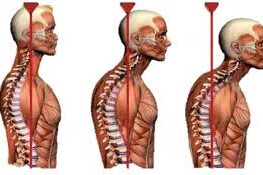
Treatment
Assuming it is nothing serious the best course of treatment is
1. Pain control –
with regular use of over the counter painkillers and/ or Acupuncture
2. Diazepam-
Occasionally with acute spasm type pain you can ask your doctor to prescribe a short course of Diazepam (Valium). This is a great muscle relaxant drug which was sadly overused for anxiety some years ago. It is addictive if taken for long periods but your GP will only give you a few days supply anyway. If it is going to help it tends to work straight away which will indicate that the pain is mainly deep muscle spasm.
The drug only works for a few days and by then you are usually on the mend.
3. Physiotherapy-
The therapist will look at the range of movements of your neck and your posture. They will then palpate the vertebrae to analyse where the problem is.
They have many gentle techniques that they can do to alleviate the pain and stiffness. These can be done in a variety of positions so if you can not lie down you can be treated sitting in a chair leaning forwards on to a pillow.
They may also suggest traction of the neck which can be done manually or via a traction machine.
Self Traction
It is possible to buy a form of traction to do yourself at home which is easy to set up over the door. The therapist will advise how much weight to put on which is controlled by the amount of water put in the bag that comes with the Traction kit.
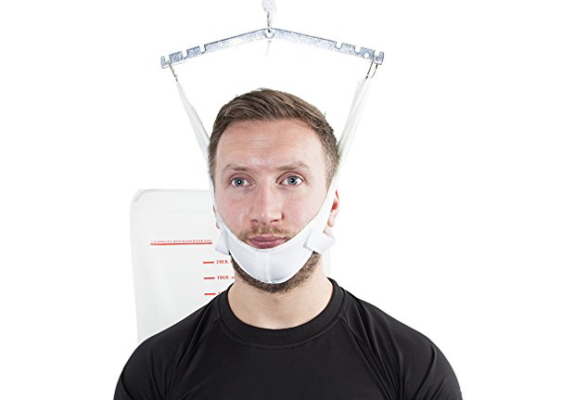
Self traction kit-
Easy to use. Works very well for acute neck problems especially with referred pain. Attaches to a door with the water bag forming the weight. This can be adjusted to suit.Instructions are in the packet.
Can be bought on Amazon
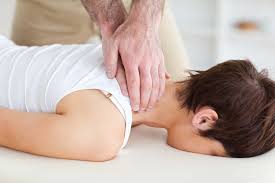
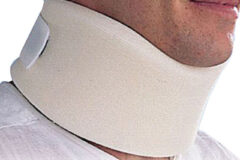
Collar
If you are in very acute pain and find it difficult to hold up your head the therapist may order a soft collar for you. This holds the head in a good position and still, which allows the pain to settle and the deep muscle spasm to ease. It is not advisable to use a collar long term but it is a great short term aid to ease the pain. It is best to remove the collar at night.
In the event of being abroad and in acute pain I suggest to patients that they can make their own collar by making rolling up a medium sized towel and wrapping it around the neck and attaching it with either a safety pin or by wrapping a scarf around it.
4. Heat-
Try a heat pad or one of those wheat packs you heat in the microwave. These mould to the shape of your neck and are very soothing.
5. Exercises–
Gentle exercises and stretches to mobilise the neck.
The physiotherapist will show you suitable gentle exercises and stretches to ease the pain, and exercises you should do to prevent any reoccurrences in the future.
See Neck exercises below
6. Pillows-
Try to place your pillows correctly at night to support the neck. Scrunch the top pillow up into the nook of the neck to support it. If you are a broad shouldered man you will need thicker pillows then a petite framed woman. The aim is to hold the neck in a neutral position not allowing the neck to fall into side bending when lying on your side.
If they pain does not settle your GP or physiotherapist may request a specialist appointment, MRI and Xray to see if there is anything more serious requiring injections or surgery.
